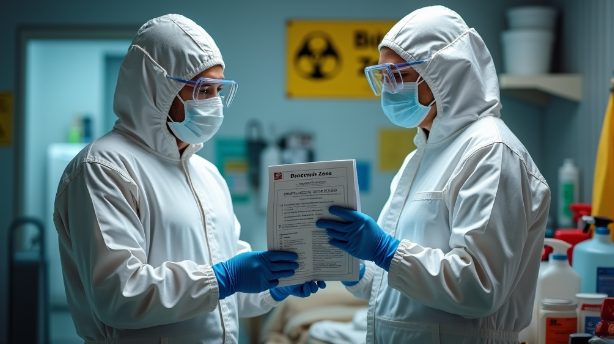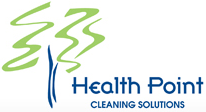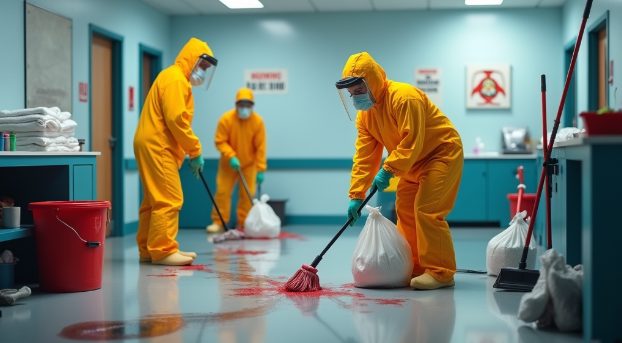If you ever face a situation with bloodborne pathogens, it means you need to act fast. These pathogens are germs that can cause serious diseases. They can be found in blood and other body fluids. It’s critical to clean up these areas correctly to keep everyone safe. You will learn about bloodborne pathogen cleanup and how to do it right.
Table of Contents
Key Takeaways
- Bloodborne pathogens are harmful germs found in blood and fluids.
- Cleanup must be immediate and thorough to prevent disease.
- Use gloves and other safety gear to protect yourself.
- Follow best practices from health authorities for safe cleanup.
- Consider hiring a professional cleanup service if needed.
For more in-depth information on safety protocols, check out our page on Workplace Safety Guidelines.
Understanding Bloodborne Pathogen Cleanup

Bloodborne pathogens include viruses like HIV and Hepatitis B. These germs can spread when someone comes in contact with infected blood or fluids. Understanding them is key to keeping your workplace safe. Phoenix has many businesses, and all must be aware of these risks.
Why Bloodborne Pathogen Cleanup is Important
When there is a spill involving blood or fluids, the area can be dangerous. People can get sick if they touch the spill without protection. This is why quick action is necessary. Cleaning properly helps to avoid spreading germs. It protects employees, customers, and anyone else who may enter the area.
| Bloodborne Pathogen | Transmission Method | Preventative Measures |
|---|---|---|
| HIV | Blood-to-blood contact | Use gloves, avoid sharing needles |
| Hepatitis B | Blood and body fluids | Vaccination, proper disposal of sharps |
| Hepatitis C | Blood-to-blood contact | Safe handling of blood products |
Steps for Effective Cleanup

When faced with a bloodborne pathogen cleanup, follow these steps:
Prepare for Cleanup
Before you start, gather your cleanup supplies. You will need:
- Disposable gloves
- Masks
- Protective eyewear
- Heavy-duty trash bags
- Disinfectants
Having these items ready makes the process easier. It also helps keep you safe.
Wear Proper Safety Gear
You must protect yourself during the cleanup. Always wear gloves to block germs from your skin. A mask can prevent you from breathing in harmful particles. Protective eyewear keeps your eyes safe from splashes.
Contain the Spill
Next, you should contain the spill. Use absorbent materials to soak up the blood or fluid. This stops it from spreading. Place these materials in a heavy-duty trash bag. Seal the bag tightly to keep it contained.
Clean the Area
Now it’s time to clean the area. Start by using a disinfectant that is effective against bloodborne pathogens. Apply it generously to the affected area. Let it sit for a few minutes to work. Then, wipe the area clean with disposable cloths.
Dispose of Materials
All items used for cleanup should be disposed of safely. Place used gloves, clothes, and trash bags in a second heavy-duty bag. Seal it tightly. Dispose of it according to your local regulations for hazardous waste.
Wash Your Hands
After completing the cleanup, wash your hands thoroughly with soap and water. If soap and water are not available, use a hand sanitizer with at least 60% alcohol. This step is crucial to remove any germs you may have missed.
Additional Cleanup Tips
- Always keep a first aid kit accessible.
- Regularly check and restock your cleanup supplies.
- Implement routine training sessions for staff.
Best Practices to Follow

When cleaning up after a spill, certain practices can help ensure safety. Here are some to keep in mind:
Train Employees
All employees should know how to react to spills. Training helps them feel more confident in handling these situations. They should understand the risks of bloodborne pathogens and how to stay safe.
Have a Cleanup Kit Ready
It’s helpful for businesses to have a bloodborne pathogen cleanup kit. This kit should include all necessary supplies. Keeping it in an easy-to-access location allows for quick responses to spills.
Follow Local Guidelines
Always stay updated with the latest health guidelines. Local health authorities in Phoenix provide resources and rules on how to manage bloodborne pathogens. Following these rules helps you maintain a safe environment.
Hire Professionals When Needed
Some situations may be too complicated or hazardous. In these cases, hiring a professional cleanup service is wise. These experts have the training and equipment to handle bloodborne pathogens safely. They can ensure thorough cleanup and compliance with all regulations.
Understanding Legal Responsibilities

There are laws and regulations around bloodborne pathogen cleanup. Employers must comply to protect their workers and customers. Understanding these laws helps you avoid serious legal issues.
OSHA Regulations
The Occupational Safety and Health Administration (OSHA) sets rules for workplace safety. They require employers to have a plan for handling bloodborne pathogens. This plan must include training and proper cleanup procedures. Failure to comply can result in fines and penalties.
Reporting Incidents
If an employee is exposed to bloodborne pathogens, it must be reported. Keeping a record of incidents can help improve safety in the workplace. It also shows compliance with regulations.
| Regulation | Requirement | Consequences of Non-Compliance |
|---|---|---|
| OSHA Bloodborne Pathogens Standard | Training for employees | Fines, legal consequences |
| Local Health Guidelines | Adhere to local cleanup procedures | Increased risk of illness, penalties |
| Incident Reporting | Document all exposures | Legal liability, increased workers’ compensation costs |
Conclusion
Bloodborne pathogen cleanup is crucial for safety. Quick and thorough action can prevent illness and protect everyone involved. Always be prepared with the right tools and knowledge. Train your staff and follow health guidelines.
When in doubt, don’t hesitate to call in a professional. Keeping your space clean from bloodborne pathogens is an essential part of maintaining a safe workplace.
Final Thoughts
In Phoenix, businesses must be aware of bloodborne pathogens. With the right knowledge and tools, you can handle these situations effectively. Remember, safety first! By following these steps, you can ensure a healthy environment for your employees and customers. Feel free to visit our website or contact us for assistance.

